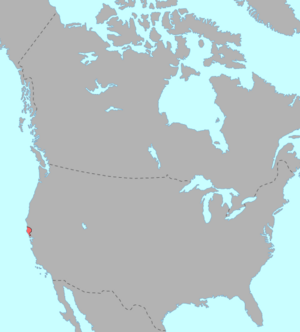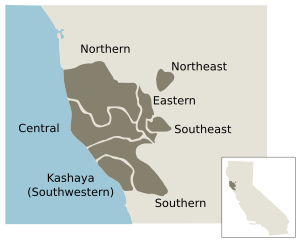Pomoan languages facts for kids
Quick facts for kids Pomoan |
|
|---|---|
| Pomo | |
| Ethnicity: | Pomo people |
| Geographic distribution: |
California |
| Linguistic classification: | Hokan ?
|
| Subdivisions: |
—
|
 Pre-contact distribution of Pomoan languages
|
|
The Pomoan languages are a group of seven languages. They were spoken by the Pomo people in northern California. Long ago, the Pomo people lived near the Russian River and Clear Lake.
Sadly, four of these languages are now extinct. The remaining languages have very few speakers. Only the Kashaya language has more than ten speakers left.
Contents
Where Pomoan Languages Were Spoken
The Pomoan languages were spoken in a specific area of California. John Wesley Powell was the first person to map out this area. He noted that the Pacific Ocean was to the west. Wintuan territory was to the east, in the Sacramento Valley. The northern boundary was the start of the Russian River. To the south were Bodega Head and the city of Santa Rosa.
Most Pomoan languages were spoken right next to each other. However, Northeastern Pomo was different. It was separated from the others by an area where Wintuan languages were spoken.
How Pomoan Languages Are Related
The Pomoan family includes seven distinct languages. John Wesley Powell was the first to officially group them together. He suggested calling them the "Kulanapan Family." However, this name was not widely used. Instead, the name "Pomo" became popular. This term was already used by both Native Americans and settlers for the Northern Pomo language. It was then used for the whole language family.
Samuel Barrett (1908) was the first to clearly identify all seven Pomoan languages. To make things simple, Barrett named each language based on its location. Examples include "Northern Pomo" and "Southeastern Pomo." This naming system became very popular. The only change was replacing "Southwestern Pomo" with "Kashaya."
Sometimes, these geographical names can be confusing. People might think all Pomoan languages are just different ways of speaking one "Pomo" language. But they are actually separate languages.
Linguists have studied how these languages are related. They have created "family trees" to show their connections. The most accepted family tree today comes from Oswalt (1964). Mithun (1999) also supports this view.
Here is how the Pomoan languages are related:
- Southeastern Pomo
- Eastern Pomo † (extinct)
- Northeastern Pomo † (extinct)
- Western
- Northern Pomo † (extinct)
- Southern
- Central Pomo † (extinct)
- Southern Pomo † (extinct)
- Kashaya (also called Southwestern Pomo)
Other researchers like Oswalt and McLendon (1978) and Campbell (1997) agree with this classification. However, Abraham M. Halpern had a different idea. He was one of the few linguists to study all the Pomoan languages.
Halpern's classification mainly differed in where he placed Northeastern Pomo. He thought it belonged with the "Western" branch of languages. He even suggested that Northeastern Pomo might have been a group that moved from the Northern Pomo area.
Proto-Pomo Language
| Proto-Pomo | |
|---|---|
| Reconstruction of | Pomoan languages |
Linguists study ancient languages to understand how modern languages developed. They try to reconstruct "proto-languages." These are the original languages from which other languages grew. For the Pomoan languages, researchers have worked to understand Proto-Pomo. This is the ancient language from which all Pomoan languages came.
One important linguist, McLendon (1973), worked on reconstructing words from Proto-Pomo. This helps us see how words in different Pomoan languages are connected.
See also
 In Spanish: Lenguas pomo para niños
In Spanish: Lenguas pomo para niños



